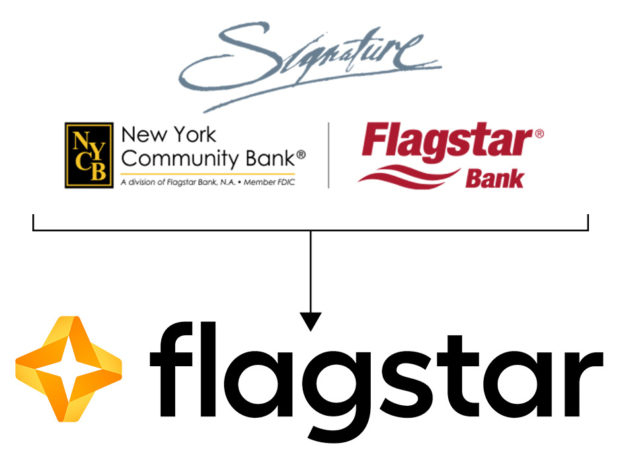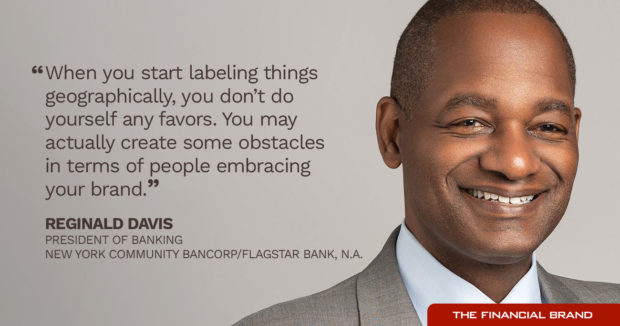There are some looks that just don’t work anymore.
There are typefaces in movie credits that might as well say “Filmed in the 1970s,” and financial institution logos can feel just as dated.
New York Community Bancorp had that — and far more — to consider in its rebranding effort.
Its acquisition of Flagstar Bank in Troy, Mich., closed in December 2022. Then it acquired parts of the failed Signature Bank in New York from the Federal Deposit Insurance Corp. in March. It set out to combine everything — including its own banking business — under the Flagstar brand.
What new look would serve to tie all of these moving parts together?
“I know this sounds cliché-ish, but both companies had a similar culture,” says Reginald Davis, president of consumer and corporate banking at the parent company. “They have a long legacy in the communities that they serve and a lot of the employees work in the same markets where they live. So we were trying to preserve that because we think that creates real connectivity in the community.”
Even so, the look had to change and not just because of Flagstar and Signature.
NYCB, which is based in Melville, N.Y., had been doing business under the names of a string of acquired New York-area institutions and the logos exuded a feel of “old New York savings bank.” Surviving names of other acquisitions in other states — such as Garden State Community Bank — likewise felt stale. The existing Flagstar logo was dated too. And, given the history, Signature’s logo wasn’t even a consideration.
“We tested our former logos and unfortunately they just didn’t survive the test of time,” says Davis, a banking veteran of over 30 years and over 100 acquisitions. “People looked at them and said, “Well, kind of stodgy and kind of formal. All the things you normally associate with a bank.'”
Ouch.
Beyond that, the existing names had become limiting.
“When you start labeling things geographically,” says Davis, “you don’t do yourself any favors. You may actually create some obstacles in terms of people embracing your brand. And we wanted to position ourselves to be more of a national brand and to appeal to a broader cross-section of customers.”

Industry Cloud for Banking from PwC
PwC’s Industry Cloud for Banking applies our deep industry knowledge to your specific business needs

Why Industry Cloud for Banking?
PwC’s Industry Cloud for Banking helps deliver personalized products and services that today’s customers expect.
Reimagining Flagstar as a Lifestyle Brand
NYCB’s $118.8 billion of assets at midyear made it the 28th-largest bank in the country.
It is sprawling, with 436 branches in 12 states, including stakes in Florida and the West, a vast wholesale mortgage business, and more than 127 (and counting) private banking teams in 10 cities.
The parent company will retain the NYCB name, with Flagstar as its banking unit. Davis, who arrived at NYCB through the Flagstar acquisition, says that no additional transactions are in sight, though the company is open to opportunities that arise, just as it was with the government-assisted Signature deal.
One of the goals is to make Flagstar into a lifestyle brand, according to Davis. The intention is to create a more approachable personality than what the banks had been projecting before.
As Davis describes it, this involves finding universal themes for its marketing approach, rather than segmenting customers based on data like income level and household assets to determine how to best appeal to them.
“There’s been an assumption that if people profiled out a certain way based on socieconomic stratification that they were similar,” says Davis. “But we’ve learned over the past few years that people who, say, earn the same, don’t look the same, don’t act the same, and don’t have the same values and aspirations.”
Something many consumers share — regardless of demographic and attitudinal differences — is the desire for guidance and education. So approachability became an important consideration in the rebranding effort. And, just as its own goal is to be perceived differently, the company also intends to challenge the perceptions banks often have about customers.
“We’re trying not to label people and put them into boxes around what we think they believe and what we think should be important to them based on the money they make,” Davis says.
Inspiration for this change of marketing heart comes in part from outside of financial services.
“Think about Nike, Jeep or Apple. They don’t necessarily care what you look like. They cross ethnicity, gender, income levels. They try to figure out who will resonate with their value set and what they stand for. Then people can connect with the brand.”
— Reginald Davis, New York Community Bancorp/Flagstar Bank, N.A.
Davis says the executives at NYCB have embraced this philosophy.
“It’s what we are trying to do. That’s very different from what a lot of financial institutions do,” says Davis.
Read more: First Horizon’s CMO Powers Through Merger Misfire with Growth Strategy
What the New Flagstar Logo Says About Its Culture
The new logo blends NYCB’s corporate colors and the Flagstar name.
The components include:
- Stars — The outer star of the logo is intended to serve as a “North Star” symbol, conveying “power, responsibility, aspiration and purpose.” The inside star stands for the relationship between the bank and customers — “who are at the center of everything the bank does.”
- The Name Block — The typeface, called “Fellix,” was selected because if conveys “openness.” The bank also says that Fellix is “clean and friendly but still has a forward-thinking style.”

The symbolism is as much for employees as anyone else. “The brand does not automatically sell someone on an organization,” says Davis. “The brand is actually what lives in the organization as part of the culture.”
The brand rollout will be teased during the fourth quarter, according to Davis. The systems conversion will be completed over President’s Day Weekend 2024. Davis refers to that point in the timeline as “Customer Day 1,” when the entire company will function as one.
Read more:
- Reviving Customer Testimonials with Flair in Huntington Ad Campaign
- Rally Credit Union’s Rebranding Campaign Plays on Its New Name

What Does a Bank Sound Like?
Though skeptics might scoff, the sound of an organization also has its place in marketing. Many brands have had tones or mini jingles that represent who they are.
Davis says he’s a car buff and he knows fellow enthusiasts who can identify as many as 15 car brands just from hearing the sounds made when the front door opens.
“Every brand has sound attributes as well as a look and feel,” says Davis. “If you go on the radio, there’s no visual cue, but a certain sound or voice gets associated with a brand.”
Davis is searching for just the right Flagstar sound.
“We’re still testing that,” he says. “We’re not quite ready to roll that out to the rest of the world yet.”
Meanwhile, the heftier NYCB has had good marks from analysts thus far. A late August report from Keefe Bruyette & Woods noted that “the evolution of NYCB is taking place in front of our eyes and the company is well on its way to realizing” the benefits of the Flagstar and Signature mergers.
If this article has got you thinking about your own brand, see:
6 Warning Signs Your Financial Institution Is Overdue for a Rebrand








